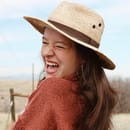One of the worst ways to lose hope is to feel foolish for harboring such a thing. Last week resembled a solemnity, at least where I live, akin to a wake or barren countryside. I’m thinking of a museum I went to a couple of years ago alone—it was dimly-lit, empty and quiet, and its art was beautiful. On the morning of Nov. 6, though, amid floating between my apartment’s own exhibits (“Roommate Group Hug,” “Turning on the TV Through Tears” and “Watching the World Outside Freeze Over, Void of its Own Glisten”), I decided nothing seemed worthy of such an identifier. Hope that morning wasn’t the thing with feathers, alive and breathing. If it were a cardinal it would’ve been easy to spot against the gray onset of winter, but I couldn’t see a scarlet-feathered wing.
For many this suggests end times—the feeling that unfolded eight years ago was maybe apprehension, and now it’s terror. Luckily, though, even if the impact feels minor at first, there are ways we can mobilize to enact positive change.
We can advocate for and engage with issues we care about.
Over the summer, I joined Sandy Hook by “Making the Promise” to protect children from gun violence. I’m a registered Promise Leader and plan to participate in their “Raising Awareness” initiatives following graduation because gun control is an important issue to me.
There are countless ways to get involved to support this issue and others. LGBTQ+ rights, reproductive rights, climate change mitigation and support for undocumented immigrants will also face challenges as we head into the next four years, and I’d be remiss to say I’m not I’m not nervous about the future of journalism as a student who’s dedicated the past three-and-a-half years of my life to understanding crisis communications, messaging, reporting best practices and information management. Fortunately, we can march, contact elected officials, attend town and board meetings, volunteer (by: phonebanking, volunteer training, language translation, letter writing, tech support tabling), donate (to: funds, independent clinics, registered nonprofits), know the laws in our state, be mindful of our consumption habits, read local news and diversify news consumption. These undertaking might be the first dominoes to fall in the series of change we need right now.
We can turn to our communities.
Lots of individuals are proactively engaging in mutual aid, a collaborative model which nurtures networks of care and generosity to meet the immediate needs of our neighbors. This might take the form of community fridges, clothing drives, educational services, letter-writing campaigns or ride-shares. Turning to your neighborhood and network to ask how you can help (or to share what kind of help you need) is a great way to start if you’re not sure what to do.
In our daily and personal lives, we can become real community members by visiting our public libraries, shopping at our local businesses, attending local shows and volunteering when possible. We can also simply try and see one another: hold open doors, help gather spilled oranges, let others pass us on the freeway if we’ve found a moment to slow down. Listen when someone’s talking, no matter how leaden or protracted their story. As recounted in the book Fearfully and Wonderfully Made, cultural anthropologist Margaret Mead declared a healed femur the first sign of a civilized society—alone the destruction of this bone would be a death sentence, but when compassion finds it, a way forward suddenly becomes visible.
We can make something.
The most helpful thing I’ve tried to remember is that creation is a wonderful companion (and sometimes substitute) to consumption. For me it’s often writing, and when I don’t have words I have music; the pads on my left hand’s fingers are more sore and calloused than ever.
Whether your art takes the form of a painting, a poem, a musical composition, a letter to a friend, a photograph or a homemade meal, it’s vital. On Friday night I attended a poetry reading—one of my favorite things to do—and one author shared the sentiment, “Where hope might falter, it can always be rebuilt.” I’ve been carrying this with me for a few days and will be for the foreseeable future, into each shadowy place, into each uncertain daybreak.


